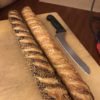Our very own Brendan was in Copenhagen recently for holiday, and Denmark has become known for its cuisine. There are now 13 Michelin-starred restaurants there including Noma — widely considered the best in the world.
And while his second-mortgage didn’t come through in time for him to try the acclaimed eatery, Brendan did eat “smørrebrød,” the Danish national lunch dish. To learn about it, he spoke with Emil Bjerg, chef at Øl & Brød, a place that does modern updates on the classic dish. First, Brendan asked Emil for a pronunciation lesson.

Emil Bjerg: Yeah, open-faced sandwich is a smørrebrød (smœrəbrœd).
Brendan Francis Newnam: Smørrebrød.
Emil Bjerg: Smørrebrød, yeah.
Brendan Francis Newnam: Is that what it means literally?
Emil Bjerg: Yeah I think it, if you translate it directly it’s smør. In English that’s butter. If you smør, you like put something on the bread.
Brendan Francis Newnam: It’s like the spread.
Emil Bjerg: Yeah, spread on the bread or butter on the spread.
Brendan Francis Newnam: Spread bread.
Emil Bjerg: Yeah, spread bread [laughs].
Brendan Francis Newnam: I think smørrebrød is a better name. It sounds a little classier.
Emil Bjerg: Yeah, exactly, exactly.
Brendan Francis Newnam: Do you know why this became the national lunch food item?
Emil Bjerg: I think it was in the ’50s, ’60s. Normally when the people went to work, they made a lunchbox at home and that was a smørrebrød. The rye bread and something on top, pretty simple.
Brendan Francis Newnam: They used to put these in a lunchbox. How do you transport that? It’s topless. How does everything not fall out?
Emil Bjerg: A lot of butter to keep it, this [gestures].
Brendan Francis Newnam: Oh, interesting. So what are the classic toppings like what’s the classic smørrebrød?
Emil Bjerg: Normally when you eat smørrebrød — when you are having dinner with the family or something — you always serve with the herring, pickled herring, with just onions, capers, sometimes like a curry, creamy curry cream. That’s the classic things to start with, and then normally you have maybe some kind of a smoked mackerel, some kind of fish like meatballs… a fish, what’s it called?
Brendan Francis Newnam: Fish cakes, like fish balls?
Emil Bjerg: Yeah, exactly. You have some different kinds of meat with the onions and stuff.
Brendan Francis Newnam: So is smørrebrød, it’s a food item, but is it also the name of like a meal? Or like do you meet for smørrebrød? Is it like tea in England?
Emil Bjerg: Yeah I think it is. If you ask somebody, “Do you want to out and eat smørrebrød?” It is- you go out for lunch and then maybe sit for one, two, two-and-a-half hours and you just take it easy, have a beer and have a snap snack of it. Normally you start off with the herring and then boom, boom, boom, boom.
Brendan Francis Newnam: How many are you allowed to eat before people think you are being a hog?
Emil Bjerg: At the restaurant we normally recommend two or three pieces, but I am a big guy and [Øl & Brød chef] Johan is a big guy, so we could probably eat four pieces. There’s no law [on] how many you can eat, but always two or more.
Brendan Francis Newnam: All right so here at your restaurant, for your lunch menu, you do smørrebrød. What are some of the sandwiches you serve here?
Emil Bjerg: We pretty much just look at the classics, herring with the onions. We do it with fennel and we do smoked mackerel with… normally we have with radish and mayonnaise and scrambled eggs. But when you have a scrambled eggs- my mom, when she made it, it was really overcooked. But we do it totally smooth and with sour cream, so it’s like almost like a porridge. It’s not like really firm.
Brendan Francis Newnam: Like a creamy consistency?
Emil Bjerg: Yeah, really creamy.
Brendan Francis Newnam: Is rye bread the default base for a smørrebrød?
Pork Terrine, Onions, Mustard from John.
A photo posted by Øl & Brød (@ol_brod) on
Emil Bjerg: Yeah, normally it is. Sometimes if you have shrimps, you normally have it on white bread but otherwise it’s rye bread, that’s the normal thing.
Brendan Francis Newnam: Do you eat them with a fork and knife or with your hands?
Emil Bjerg: Fork and knife.
Brendan Francis Newnam: Always? I mean not just at your restaurant, that’s usually the way?
Emil Bjerg: Yeah usually the way, usually. Yeah, always eat it with a fork and knife unless you’re in a hurry and you just do like a rye bread with something at home, then it’s just by hand.
Brendan Francis Newnam: If you expand to America this might be a problem because we only are given 10 minutes for lunch and we need to eat on the go. Fork and knife might be too complicated for us.
Emil Bjerg: Yeah, probably I think.
Brendan Francis Newnam: There’s not going to be a mixed smørrebrød anytime soon I don’t think.
Emil Bjerg: Nah, I don’t think so.
Brendan Francis Newnam: All right so, here we have a smørrebrød. This is exquisite, what are we looking at?
Emil Bjerg: This is the herring, pickled herring, dill, onions, pepper, and then on top we have dill mayonnaise. We have some pickled fennel, some raw fennel, raw apples, some onions and tarragon. So it’s really a light, fresh start for the lunch.
Brendan Francis Newnam: All right so I’m going to take a bite. This is going to be hard because I have to hold a microphone and use a fork on knife so I’m going to put this down for a second. All right so I’m going to taste this here. What do you say in Denmark before you eat? Do you say Bon Appetit or?
Emil Bjerg: Velbekomme.
Brendan Francis Newnam: Velbekomme?
Emil Bjerg: Yeah.
Brendan Francis Newnam: [Tastes smørrebrød] Delicious! It’s a sweet crispness on top of the saline rich herring. This is excellent! Do you think it’s technically a sandwich because I feel like we almost have a- it’s more like bruschetta. I don’t know if even qualifies as a sandwich.
Emil Bjerg: I don’t see that’s a sandwich. Somebody says sandwich to me, I think like a normal sandwich. I think smørrebrød is just smørrebrød.
Brendan Francis Newnam: Because in America we like to like eat while we’re drive our trucks and it’d be really hard to steer while eating an open faced sandwich.
Emil Bjerg: Yeah you couldn’t do that. I think it would be a risk to yourself and others.


